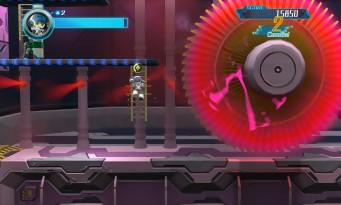 So here it is, the new game from the creator of Megaman. Interesting. Well, let's first evacuate the elephant in the room: we must admit that filiation is difficult to deny. Without a doubt, Mighty No. 9 is a Megaman that does not bear his name, and that translates to almost every level. The action-platform gameplay which takes up exactly that of the series initiated on the NES, a humanoid robot for hero, the backstory based on out-of-control androids, the team of nine Mighty: everything smells of the Megaman at full nose. Or almost.
So here it is, the new game from the creator of Megaman. Interesting. Well, let's first evacuate the elephant in the room: we must admit that filiation is difficult to deny. Without a doubt, Mighty No. 9 is a Megaman that does not bear his name, and that translates to almost every level. The action-platform gameplay which takes up exactly that of the series initiated on the NES, a humanoid robot for hero, the backstory based on out-of-control androids, the team of nine Mighty: everything smells of the Megaman at full nose. Or almost.
BORN IN THE 90's
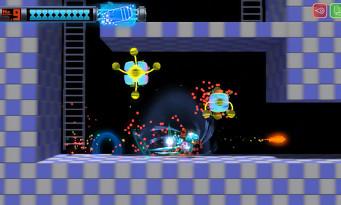 Come on, let's start with what is obvious: the game may persevere in old-school 2D gameplay, it is nonetheless made in 3D, on Unreal Engine. THE question is: what version of the engine did the little Comcept guys use? Because Mighty N°9 isn't very pretty, and that's an understatement. Despite the few elements displayed on the screen, everything seems to date from the end of the 90s; all that's really missing is the aliasing to match the mood. It still goes a bit far in the fan service, huh. The problem is that the artistic direction, which usually saves the day in this kind of case, pushes the nails a little more. From the bland backgrounds to the abstruse design of certain enemies (a trash can? a pallet truck?!) to the naughty secondary characters, nothing really stands out, everything is deja vu and generic. Only some of the Mighty get away with it. Well, OK, let's admit, visually, it's really not the best. But controller in hand, Mighty No. 9 also suffers from problems far too important to ignore.
Come on, let's start with what is obvious: the game may persevere in old-school 2D gameplay, it is nonetheless made in 3D, on Unreal Engine. THE question is: what version of the engine did the little Comcept guys use? Because Mighty N°9 isn't very pretty, and that's an understatement. Despite the few elements displayed on the screen, everything seems to date from the end of the 90s; all that's really missing is the aliasing to match the mood. It still goes a bit far in the fan service, huh. The problem is that the artistic direction, which usually saves the day in this kind of case, pushes the nails a little more. From the bland backgrounds to the abstruse design of certain enemies (a trash can? a pallet truck?!) to the naughty secondary characters, nothing really stands out, everything is deja vu and generic. Only some of the Mighty get away with it. Well, OK, let's admit, visually, it's really not the best. But controller in hand, Mighty No. 9 also suffers from problems far too important to ignore.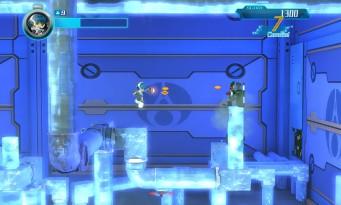 As we said above, Beck handles pretty much like Megaman. It also has a dash command that allows you to absorb an enemy that you have weakened beforehand, and thus obtain a temporary bonus (defense, speed or firepower). The faster you absorb the opponent after hitting them, the higher the absorption rate, paving the way for a combo system that was included more for aesthetics, replay value and challenge. artificial than game structure. The truth is that we can do very well without it. And it's not the only "essential" feature of Mighty N°9 that we can easily do without. Thus, the title takes up the now well-known system of assigning the hero the power of each defeated boss. Either, it's as old as the world but it's solid. But here, out of the eight powers that you will recover, only one or two are really useful or pleasant to handle (some conferring on the contrary a completely disproportionate advantage)! Before the very last level, nothing really encourages you to vary the approaches: neither the ultra-loose manipulation to perform to switch between powers, nor the very uneven level-design, nor the enemies, which can be apprehended in the same way whatever your shape. In fact, we got through most of the game with classic Beck gear without even using a transformation.
As we said above, Beck handles pretty much like Megaman. It also has a dash command that allows you to absorb an enemy that you have weakened beforehand, and thus obtain a temporary bonus (defense, speed or firepower). The faster you absorb the opponent after hitting them, the higher the absorption rate, paving the way for a combo system that was included more for aesthetics, replay value and challenge. artificial than game structure. The truth is that we can do very well without it. And it's not the only "essential" feature of Mighty N°9 that we can easily do without. Thus, the title takes up the now well-known system of assigning the hero the power of each defeated boss. Either, it's as old as the world but it's solid. But here, out of the eight powers that you will recover, only one or two are really useful or pleasant to handle (some conferring on the contrary a completely disproportionate advantage)! Before the very last level, nothing really encourages you to vary the approaches: neither the ultra-loose manipulation to perform to switch between powers, nor the very uneven level-design, nor the enemies, which can be apprehended in the same way whatever your shape. In fact, we got through most of the game with classic Beck gear without even using a transformation. PEAKS OF DIFFICULTY
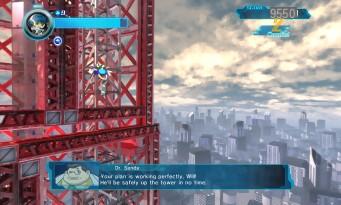 We could talk about a walk in the park, especially since you can choose the number of lives you have from the start of the game (up to nine per Game Over) and you can receive different bonus items each respawn (a deactivable option for the most relentless). But the difficulty yo-yos fairly regularly, leading to some pretty annoying pacing issues. The enemy robots pose very few problems during most of the game. The bosses require a few rounds of observation before they can claim victory. And, from time to time, without really warning, the game throws us phases of pointed platforms where the slightest deviation is synonymous with immediate death, and therefore a repeated nervous breakdown due to a collision poorly rendered the screen. Not enough to extend the life of the solo however, which should not exceed five hours of play.
We could talk about a walk in the park, especially since you can choose the number of lives you have from the start of the game (up to nine per Game Over) and you can receive different bonus items each respawn (a deactivable option for the most relentless). But the difficulty yo-yos fairly regularly, leading to some pretty annoying pacing issues. The enemy robots pose very few problems during most of the game. The bosses require a few rounds of observation before they can claim victory. And, from time to time, without really warning, the game throws us phases of pointed platforms where the slightest deviation is synonymous with immediate death, and therefore a repeated nervous breakdown due to a collision poorly rendered the screen. Not enough to extend the life of the solo however, which should not exceed five hours of play. The analysis of the patterns, which is an interesting moment in the confrontation, finds itself weighed down by a badly-made switch between the powers
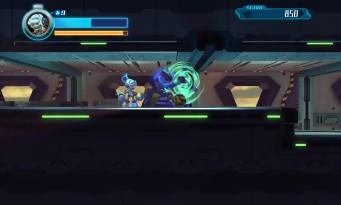 What then remains to be saved in this Mighty N°9? The impression of sometimes capturing a few extracts from Megaman, in particular in the boss fights, where the analysis of the patterns, which is an interesting moment in the confrontation, finds itself weighed down by a badly made switch between the powers. The dash system would also have deserved much better integration, and the secondary challenges are an opportunity to do it justice. Finally, we will note the very complete dubbing, the possibility of having music (unfortunately not very significant) in an 8-bit version.
What then remains to be saved in this Mighty N°9? The impression of sometimes capturing a few extracts from Megaman, in particular in the boss fights, where the analysis of the patterns, which is an interesting moment in the confrontation, finds itself weighed down by a badly made switch between the powers. The dash system would also have deserved much better integration, and the secondary challenges are an opportunity to do it justice. Finally, we will note the very complete dubbing, the possibility of having music (unfortunately not very significant) in an 8-bit version.

























